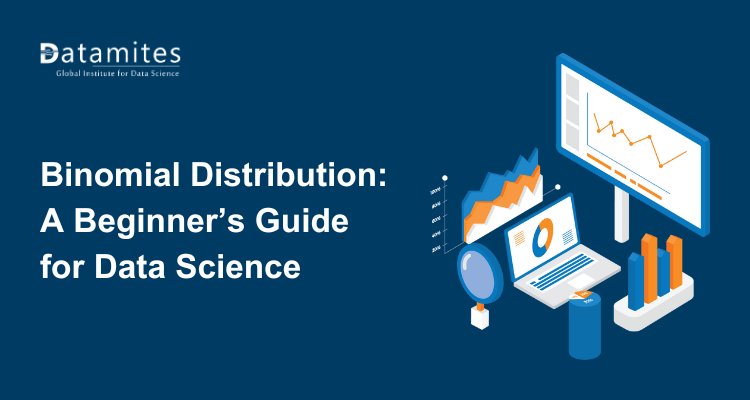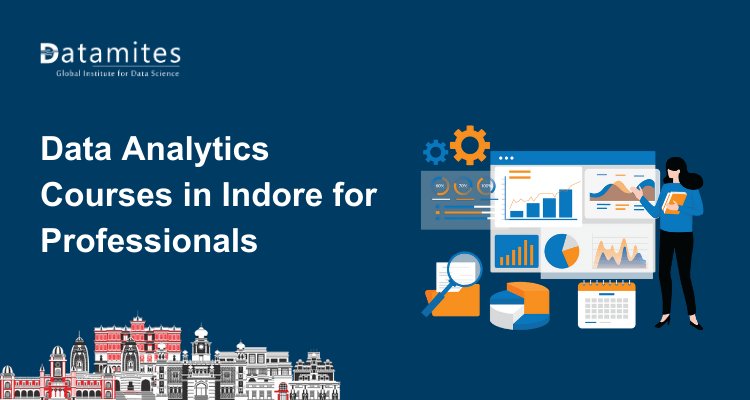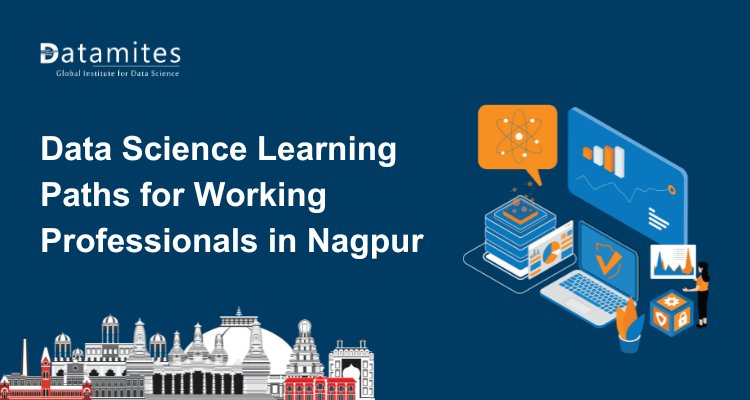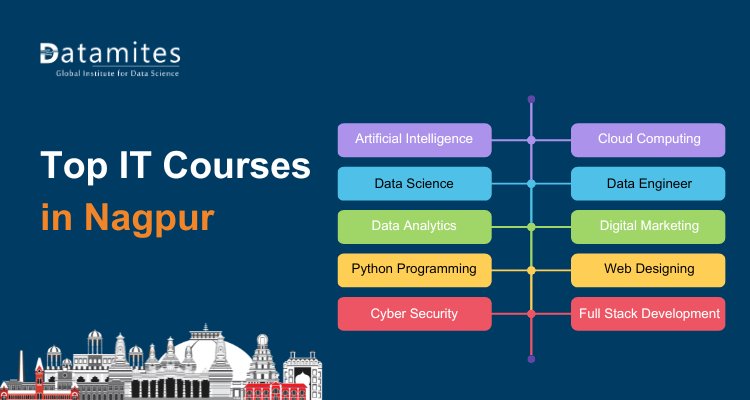Binomial Distribution: A Beginner’s Guide for Data Science
This guide introduces Binomial Distribution for data science beginners, explaining its principles, formulas, and applications in probability, statistics, and machine learning for practical data analysis.

Imagine flipping a coin five times and wondering, “What’s the chance of getting exactly three heads?” Or picture a marketing team sending promotional emails to 100 people and predicting how many will make a purchase.
Both situations involve probability, a core concept in Data Science that helps professionals make data-driven decisions.
As the demand for Data Science continues to surge globally, understanding such foundational concepts becomes essential. Whether you aim to build a career in Data Science or explore machine learning basics, probability distributions like the Binomial Distribution form your analytical backbone.
In this blog, we’ll explore what Binomial Distribution means, how it works, and why it’s so important in Data Science for beginners. You’ll also see how mastering these topics can strengthen your Data Science skills and open pathways to become a Data Scientist ready for the future.
What is Binomial Distribution?
In simple terms, the Binomial Distribution describes the probability of getting a certain number of successes in a fixed number of independent experiments each with the same chance of success.
For instance, if you flip a coin 10 times, each flip has two possible outcomes heads or tails and each outcome has an equal chance of occurring. The binomial distribution helps you calculate the probability of getting, say, exactly 7 heads out of those 10 flips.
Mathematically, it’s based on:
- n: number of trials
- p: probability of success
- q (1 – p): probability of failure
These are simple yet powerful ideas. You don’t need to be a statistician to grasp them you just need to think logically about chances and outcomes.
For anyone looking to become a Data Scientist, learning this concept is crucial. It’s one of the core data science skills that supports everything from predictive modeling to experiment design. Understanding probability in this way also enhances your problem-solving mindset a valuable asset for any Data Science career.
Key Features of Binomial Distribution
The Binomial Distribution in Data Science has a few defining characteristics that make it useful in real-world applications:
- Fixed Number of Trials: The number of experiments (n) is predetermined for instance, checking 100 products for quality.
- Two Possible Outcomes: Each trial can only have two results success or failure. A customer either buys a product or doesn’t.
- Constant Probability: The probability of success remains the same across all trials. For example, if there’s a 20% chance that a person clicks an ad, that rate stays consistent for each viewer.
- Independent Trials: Each trial’s outcome doesn’t affect the next every experiment stands alone.
These properties make the Binomial Distribution ideal for binary situations in data analysis techniques.
Practical examples include:
- Estimating how many customers will respond to an email campaign.
- Predicting defect rates in a manufacturing process.
- Determining pass/fail outcomes in student exams.
By mastering these foundational ideas, you strengthen your analytical mindset a must-have for anyone serious about pursuing a career in Data Science or staying ahead in emerging data science trends.
Refer to these articles:
- Box Plot in Data Science: How to Visualize Data Spread
- Covariance in Data Science: What It Means and Why It Matters
- Understanding Hadoop in Data Science
Practical Calculation of Binomial Distribution with Example
The formula for the Binomial Distribution is:
P(X = k) = (n choose k) * p^k * (1 - p)^(n - k)
Where:
- P(X = k): Probability of getting exactly k successes
- n: Number of trials
- k: Number of successes
- p: Probability of success
- q (1-p): Probability of failure
Let’s see this with a simple example.
Example: If you flip a coin 5 times, what’s the probability of getting exactly 3 heads?
Here, n = 5, k = 3, p = 0.5
P(X = 3) = 10 × 0.125 × 0.25 = 0.3125
So, there’s a 31.25% chance of getting exactly 3 heads in 5 flips.
Such calculations build a strong understanding of probability in Data Science, enabling beginners to interpret uncertainty a skill that directly applies to modern Data Science careers and machine learning basics.
Real-World Applications in Data Science
The Binomial Distribution isn’t just a theoretical concept it plays a critical role in practical Data Science projects. Here are some key applications:
- A/B Testing in Marketing: Companies often test two versions of a website or email campaign to see which performs better. Each visitor either converts (success) or doesn’t (failure). The binomial distribution helps predict the probability of conversions and identify the better-performing variant.
- Predictive Modeling and Classification: In binary classification problems, like predicting whether a loan will default or a transaction is fraudulent, each outcome is success/failure. Data scientists use binomial probability to estimate expected outcomes and evaluate model performance.
- Risk Assessment and Decision-Making: Businesses use binomial distribution to measure the likelihood of success or failure in projects, investments, or operational processes. For example, predicting the number of defective products in a batch or the probability of meeting quarterly targets.
- Healthcare Analytics: Medical researchers use binomial distribution to estimate treatment success rates. For instance, predicting how many patients will respond positively to a specific medication or therapy.
- Customer Behavior Analysis: Retailers can model purchase probabilities such as the likelihood of customers buying a promoted product. Each customer’s action is treated as a success/failure event.
- Quality Control in Manufacturing: Factories analyze product batches for defects. Each item is either defective or not, making binomial distribution ideal for predicting defect rates and maintaining quality standards.
Such use cases show the scope of Data Science in diverse industries from healthcare and retail to finance and technology. They also reflect the demand for Data Science professionals who understand not only coding but also probability and statistics the building blocks of smart analytics.
Refer to these articles:
- Impact of Automation on Data Science Jobs
- The Anatomy of a Data Science Project: From Hypothesis to Insight
- How to Build Data Pipelines: Step-by-Step Guide
Why Data Scientists Should Learn Binomial Distribution
Mastering the Binomial Distribution in Data Science strengthens your understanding of how probability drives decision-making. Here’s why every aspiring data scientist should learn it:
- It sharpens your understanding of statistical methods in data science, which are crucial for model evaluation and hypotheses testing.
- It builds intuition for probabilistic thinking, vital for advanced models like logistic regression and Bayesian analysis.
- It enhances your ability to design experiments and interpret results in machine learning and business analytics.
Keeping up with the latest data science trends and deepening your knowledge of statistics can accelerate your path to becoming a Data Scientist.
The Binomial Distribution may seem simple, but it plays a powerful role in the foundation of Data Science concepts. It helps analysts and data scientists predict outcomes, measure uncertainty, and make confident, data-driven decisions.
For anyone planning to build a career in Data Science, mastering topics like this is essential. These are the Data Science skills that separate theoretical learners from practical professionals. If you’re wondering how to be a Data Scientist, start by building your understanding of probability, statistics, and real-world problem solving. Enroll in a professional Data Science course that emphasizes practical applications and career readiness.
With the right foundation, you’ll not only understand probability you’ll know how to apply it to shape the future of analytics, business, and AI. According to Grand View Research, the global data science platform market was valued at USD 96.25 billion in 2023 and is projected to grow at a CAGR of 26.0% from 2024 to 2030, highlighting the immense demand for data science professionals and the vast opportunities across industries.
Embark on your Data Science journey now and gain the skills that industries are actively seeking. Enrolling in data science training in Hyderabad, Pune, Ahmedabad, Bangalore, Chennai, Coimbatore, or Mumbai can provide you with practical knowledge, hands-on project experience, and expert career guidance to step confidently into this booming field. With the ever-growing demand for data science, gaining the right training can open doors to diverse and rewarding opportunities.
Among the leading institutes, DataMites Institute stands out for its industry-oriented curriculum and focus on experiential learning. With live projects, internship opportunities, and dedicated placement assistance, DataMites ensures learners gain real-world exposure while effectively bridging the gap between classroom concepts and practical applications.
The Certified Data Scientist course at DataMites, accredited by IABAC and NASSCOM FutureSkills, cover essential tools, machine learning workflows, and advanced analytics skills that are highly in demand across finance and many other sectors. For those who prefer classroom learning, DataMites offers data science courses in Delhi, Pune, Chennai, Mumbai, Bangalore, Hyderabad, Ahmedabad, and Coimbatore. Learners who seek flexibility can opt for DataMites online courses, which deliver the same high-quality education globally.





